|
Many people are surprised at the number of plant species at Tonto National Monument, especially trees and shrubs. This is due in part to two rainy seasons. We get an average of 16" of rain annually, with approximately half of it falling during the summer months. This is, of course, just when the trees are able to make use of it. The winter rains are responsible for our spring wildflowers (or lack thereof!) Many of the trees and shrubs were used by native people for food, medicine, building materials, clothing, etc. The following is not a complete list of plants found here, but includes the more common trees and shrubs. Learn about each of these plants below. 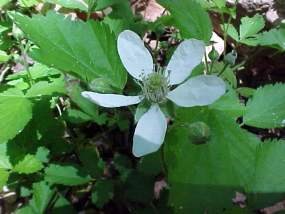
NPS Photo Arizona DewberryRubus arizonensis This deciduous shrub grows low to ground. It has green, serrated leaflets, generally in groups of three or five, and white flowers. Their fruits resemble blackberries or raspberries.Uses: - The berries were eaten fresh, or pressed into cakes, dried, and stored for winter use. - A purple to dull blue dye can be obtained from the fruit. - Some species were used to treat diarrhea, rheumatism, piles, boils, stomach trouble, infect sores, sore throats, venereal disease, cough, fever, and to regulate urination. 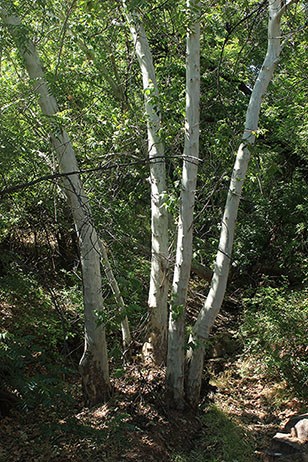
NPS Photo/ J. Smith Arizona SycamorePlatanus wrightiiThis large deciduous tree has white bark and maple-like 3 to 4 lobed leaves. It has red flowers in cluster of 2 to 4 and dangling brown seed balls. This tree must have its roots in water to survive; they are always found in riparian areas. Uses: -The wood was use for lumber and sycamore vigas were found in both the Upper and Lower Cliff Dwellings. - The leaves were used to wrap bread during baking. - Various species were used during a women's menstrual period, as a blood purifier, as a wash for infected sores and diaper rash, for dysentery, indigestion, cough, colds, measles, smallpox, tuberculosis, asthma, ulcers, rheumatism, eczema, sore throats, and to treat knife or axe wounds. 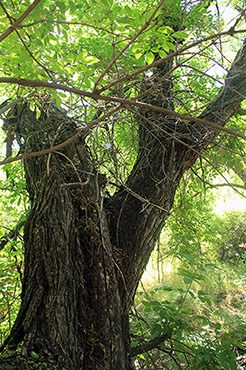
NPS Photo/ J. Smith Arizona WalnutJuglans majorThis tree has grayish-brown bark that is furrowed on mature trees. The leaves are alternate and odd-pinnately compound with 9 to 15 yellowish green above, light green below, serrate, lance-shaped, point-tipped, slightly curved leaflets. The small nut has a thick shell with deep groves that encloses an oily, edible seed. Uses: - Walnuts were gathered and eaten. They are an excellent source of vitamins and minerals. - Trees were used in construction and the husks, shells, and twigs were boiled for dye or black paint. 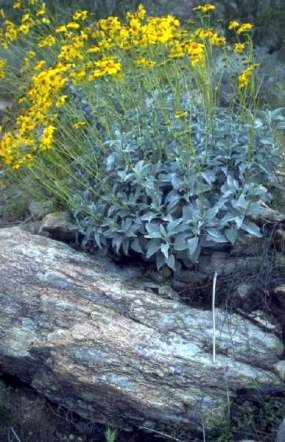
NPS Photo BrittlebushEncelia farinosaThis medium-sized shrub has long, oval, silver-gray leaves that are somewhat fuzzy. These hairs act like a blanket over the leaves to protect them from the heat and cold. In early spring, it has small yellow flowers that form on long stems well above the leafy stems. Uses: - The upper branches produce a resin that can be chewed like gum, used to waterproof pottery, attach trailheads, and as pain relief. - The plant can be used to treat fevers, allergies, arthritis, poison ivy, mouth sores, and tooth and gum pain. The resin could be heated to treat a toothache or smeared on the chest and side to relieve pain. - The branches make a quick fire. 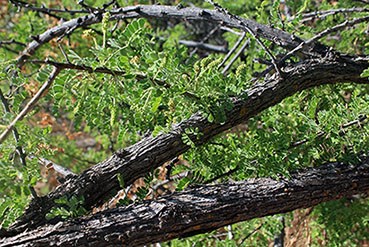
NPS Photo/ J. Smith Catclaw AcaciaSenegalia greggiiThis large, deciduous shrub has bipinnately compound gray-green leaves. The cream colored blooms are produced in dense cylindrical spikes. The fruit is a flat pod that generally contains 3 to 5 brown seeds. Uses: - Seeds are edible and are a good source of protein. Prods are eaten fresh or dried and ground into flour. - Was used medicinally as an astringent, disinfectant, and an anti-inflammatory. - Branches were used for firewood, building, fences or bow. Twigs were used to brush off metates, to make baskets, and to make animal hides more pliable. 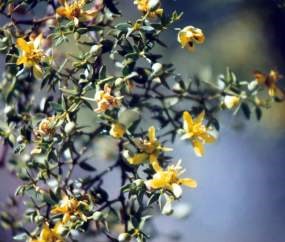
NPS Photo CreosoteLarrea tridentataThis evergreen shrub has dark green leaves with two opposite leaflets joined at the base and yellow flowers. The plant gives off a characteristic odor of creosote, from which the common name derives. The smell is often associated with the smell of rain. Uses: - This plant had literally hundreds of medicinal uses. Parts of the plant were used as a mild sunscreen or massage oil, to treat arthritis, sciatica, rheumatism and other respiratory problems, dry skin, brittle hair and nails, cracked hands and feet, fever, influenza, colds, stomach cramps, gas, gout, constipation, venereal diseases, menstrual cramps, sinusitis, anemia, cuts, abrasions, burns, fungal infections, allergies, autoimmune diseases, pain, and diarrhea. - Gum from the bark, which is like a shellac, was used to mend broken pots, waterproof baskets, and attach arrowheads. 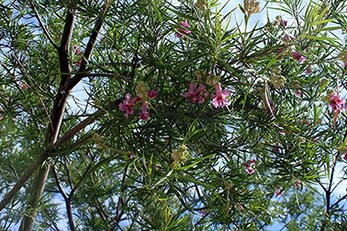
NPS Photo/ J. Smith Desert WillowChilopsis linearisThis slender-twigged, deciduous plant is a small tree or a large shrub, often with a leaning, twisting trunk and open, spreading crown. It has willow-like, light green leaves and a funnel-shaped dark pink or purple flower. Although it resembles a willow, it is actually related to catalpa trees. Uses: - A weak tea made from dried flowers was used as a hot poultice. It contain salicylates, compounds similar to those found in aspirin. The plant can be used to relieve pain, reduce inflammation, help lower fevers, and treat infections. - Willow wood is lightweight, strong, and does not rot easily. Desert will branches are so pliable that they can be bend nearly in half without breaking. It was used in constructing homes or granaries, and made into bows, craddleboards, or poles to harvest cactus fruit. The bark was used to make shirts, breechclouts, and nets. 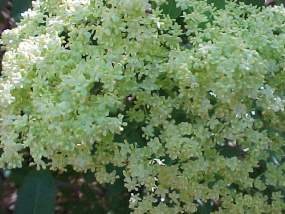
NPS Photo Common ElderberrySambucus nigraThis small deciduous shrub has gray or brown, furrowed bark with opposite, pinnately compound leaves. The flowers are ivory white in flat-topped clusters. It produces a dark purple to black berry in dropping clusters in late autumn. Uses: - The berries are edible when cooked. Berries could be dried or smashed for cakes and mush. - Washes were made from the bark to soothe external sores. - Stems were used to make an orange dye while berries were used to make black or purple dye. 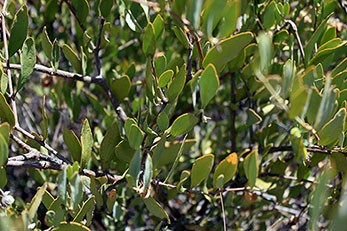
NPS Photo/ J. Smith JojobaSimmondsia chinensisThis intricately branched evergreen bush has leathery, grayish-green levels. It is a dioecious species, meaning there is a male plant and female plant. Male yellowish-green flowers are borne in clusters. Female pale green flowers are borne singly and oblong seeds are produced in summer. Uses: - The nuts were made into cakes, eaten fresh, made into a nut butter, and roasted and made into a coffee like beverage. - Jojoba oil was used in cooking oil, shampoo, hair and body oil. - Sores or scalp problems were treated by cooking the fruits in hot ashes and crushing them. This salve was spread over the affected area. Sore eyes were treated by putting ground jojoba seeds into a straining cloth and squeezing the oil directly into the eye. Chewing raw green seeds was said to help a sore throat. 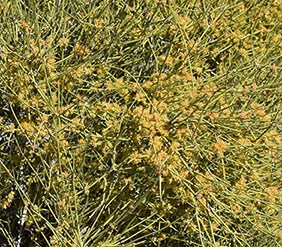
NPS Photo/ S David Mormon Tea (Mexican Tea)Ephedra trifurcaThis erect, yellowish-green shrub has terminal stems that are thin, green, and essentially leafless. It bears papery cones. Uses: - The leaves and stalked were boiled in water to create a tea. The tea was used to cure canker sores, kidney ailments, urinary tract infections, relieve cold symptoms, eliminate ulcers and relieve stomach disorders. - The plant contains a small amount of ephedrine which helps with hay fever, allergies, mile asthma, and coughs. 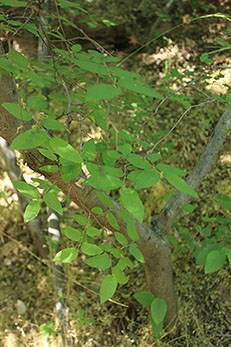
NPS Photo/ J. Smith Neatleaf HackberryCeltis reticulataThis small, deciduous shrub has gray to white bark and alternate simple leaves. It has small, greenish flowers and orange-red fruits. Uses: - Berries were eaten fresh or dried for winter use. Parts of the plant were used for indigestion, sore throat, venereal diseases, and as a "woman's medicine". - The wood was used for firewood, bows, or to make handles for axes and hoes. The bark was used to make sandals. 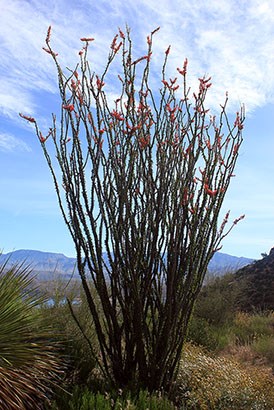
NPS Photo/ J. Smith OcotilloFourquieria spledensOctoillos have several long, whip-like, spiny stems that grow upward for perhaps 20 to 30 feet from a root crown. They have 2" long green leaves that appear soon after a rain falls that wither and fall off as the soil dries- a cycle that may be repeated several times throughout the year. It produced a red cluster of flowers at the end of its stem during the spring. Uses: - The seeds and flowers are both edible and contain 29% protein and 19% fat. They were ground into flour and used to make mush or cakes. Equal parts water and flower, soaked overnight and then strained, made a lemony, slightly sweet punch. - The powdered root was used to reduce swelling, and to relieve fatigue and sore, swollen muscles. - Branches placed in the ground and watered every few days made living fences in a few weeks. The resinous wood also made food torches, firewood, and four house construction. 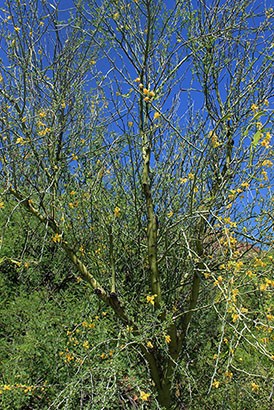
NPS Photo/ J. Smith Foothill Palo VerdeParkinsonia microphyllaThis small tree or large shrub has smooth green bark. The branches are spin-tipped, stiff and upright. It has very little leaves and when in bloom, the flowers are bright yellow. These trees can live to be more than 100 years old, possibly as old as 400 years. Palo Verde is Spanish for green stick referring to the tree's green bark. Uses: - The peas of all the indigenous species are edible. When green, they taste similar to the domesticated pea, but sweeter and firmer. They are rich in Vitamin A. Eat them fresh, in salads, as sprouts, or cooked. - The trunks and larger branches can be made into ladles or pry bars to uproot agaves. The wood is soft and brittle and burns very quickly, giving off an unpleasant odor and leaving few coals. To seal pottery, boil the ground seeds and skim off the scum, and rub it into the exterior. 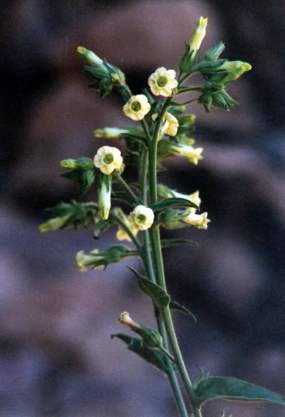
NPS Photo Tree Tobacco (Desert Tobacco)Nicotiana glaucaThis invasive plant is native to South America and was introduced in the United States in the early 1800s as a landscape ornamental plant. It is a slender, straggling shrub that grows up to 8 feet tall. It have bluish-gray leaves and small, tubular, cream- colored, greenish-white flowers that form at the branch ends. Tree tobacco is toxic to humans and animals. Uses: - It contains anabasine which can be extracted to be used as an insecticide. 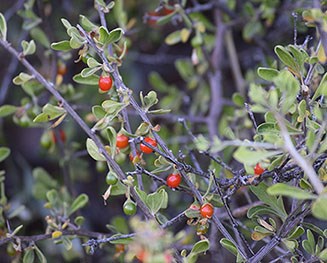
NPS Photo/ S David WolfberryLycium spp.There are many species of wolfberry. All are thorny, wood shrubs of varying ultimate size. They have small narrow leaves, small pale pink to lavender flowers and orange to red colored berries. Uses: - All Sonoran desert species have fruit tat are edible as is, dried, or cooked. Boil and mash the berries and drain the liquid as a beverage, or grind them and mix with a little clay before eating. - The berries contain all 8 essential amino acids, niacin, several B vitamins, calcium, as much vitamin C as oranges, as much protein as bee pollen (10 - 35%, depending on the source), and as much beta carotene as carrots. - Various parts of the plant can be used to treat allergies, external pain and inflammation, nausea, and intestinal spasms. 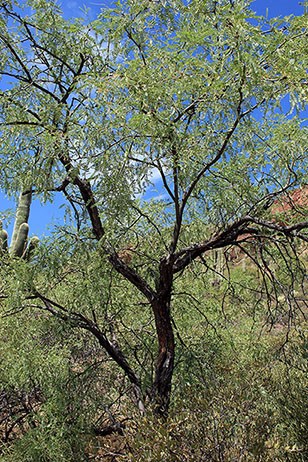
NPS Photo/ J. Smith Velvet MesquiteProsopis velutinaThis deciduous tree has alternate, bipinnately compound leaves, each with 9 to 30 pairs of leaflets. It has yellow flowers that form in dense cylindrical clusters. Long seedpods form from the flowers. The bark is dark brown, thick, and has a shredded texture. Uses: - A very important food source: it was the mesquite flour gruel that sustained them during the winter and early spring. Beans would be placed on the roof to completely fry and then stored for future use. The beans contain about 35% protein, more than soybeans. Mesquite flour provided protein, carbohydrates, and calcium. - The flowers were picked and roasted or made into a tea. The tea is used as a cleaning disinfectant for cuts and abrasions and as an eyewash for pinkeye. It could also be used to treat dyspepsia, ulcers, hemorrhoids, dysentery, and diarrhea. - The bark sap could be used as antiseptic for open wounds. The bark could be boiled and used as a laxative and emetic. |
Last updated: July 18, 2017
